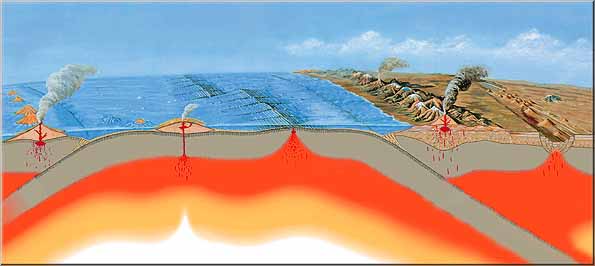You will need to look through the pages associated with these four topics to answer the following questions.
The USGS has a wonderful
web site about the North Cascades that we'll be exploring this term.
The home page is at
http://www.nature.nps.gov/geology/usgsnps/noca/noca1.html
Notice that it has links to "Plate Tectonics" and "Rocks and Minerals". These are the topics that will be covered during the first homework.
Section 1: Plate Tectonics - Click on the button that says Plate Tectonics, or go to http://www.nature.nps.gov/geology/usgsnps/pltec/pltec1.html
You will see
You will need to look through
the pages associated with these four topics to answer the following questions.
1) a) What is the average
thickness of the oceanic crust - give your answer both in km and miles
b) What
is the average thickness of the continental crust - give your answer both
in km and miles
2) a) How is the mantle different
from the crust?
b) How
is the lithosphere different from the mantle?
c) How
is the lithosphere different from the asthenosphere?
d) What
do we mean when we talk about a "plate"?
3) a) How fast do the fastest
plates move - give your answer in both cm/yr and inches/yr?
b) How
slow do the slowest plate move - give your answer in both cm/yr and inches/yr?
4 a) Which young divergent
plate boundary does this site mention?
b) What type
of lithosphere forms at a divergent plate boundary?
c) What are
the two names that this site uses to describe the chain of volcanic mountains
that forms at a divergent boundary?
5) a) Explain what is meant
by "subduction"
b) What
happens when two oceanic plates collide?
c) Why
don't we have subduction when two continents collide?

The image above is from:
http://www.nature.nps.gov/geology/usgsnps/pltec/vigilim.html
Please print out this picture and label the following: A - a hot spot volcano; B - a subduction zone volcano at an oceanic/continent collision; C- a subduction zone volcano at an ocean/ocean collision; D - a transform plate boundary; E - a divergent plate boundary with a mid-ocean ridge; F - a divergent plate boundary with a rift valley on a continent; G - oceanic crust; H - continental crust; J - lithosphere; K - asthenosphere.
Section II: Rocks and
Minerals - this information is actually scattered throughout the web site.
The first thing you need to figure out is why a mineral is not a rock.
There are two pages you need to look at:
The most common minerals
are covered on http://www.nature.nps.gov/geology/usgsnps/rxmin/mineral.html#quartz
The definition of a mineral
is given at the bottom of the page: http://www.nature.nps.gov/geology/usgsnps/noca/sb3mins.html
6) Figure out what part of the paragaph on the page given above is the actual definition of a mineral and type that definition up word for word (giving me neither too much information nor too little).
Rocks are covered on two pages. It is best to read: http://www.nature.nps.gov/geology/usgsnps/noca/nocageol2.html first, and then go to http://www.nature.nps.gov/geology/usgsnps/rxmin/rock.html
7) Once you have looked at the pages above, give me a brief explanation of how a rock is different from a mineral.
From here on, you need to take the initiative to follow links to see where they go.
8) a) What is an igneous
rock?
b) How
does an extrusive rock differ from an intrusive rock? (Hint - there is
a nice diagram at http://www.nature.nps.gov/geology/usgsnps/noca/nocageol2a.html
)
9) For this one, look at
the charts at http://www.nature.nps.gov/geology/usgsnps/rxmin/igclass.html#
and tell me
a) How
does a basalt differ from a gabbro?
b) How
does a tonalite differ from a granite?
10) a) What is a sedimentary
rock?
b) How does a clastic rock differ from a chemical rock?
11) a) What is a metamorphic
rock?
b) How does a foliated rock differ from a nonfoliated rock?
At this point you should
look at your textbook (or any other web site you choose to look at-but
then give me a reference) - you will be running accross the following metamorphic
rocks throughout this web site - you should have some idea of whether these
require a little or a lot of metamorphism: slate, schist, gneiss, amphbolite,
greenstone, The latter two rocks are discussed at http://www.nature.nps.gov/geology/usgsnps/noca/nocageol2cm.html
- there is no question on this, but you will see these terms again
and again, so you might as well get started.